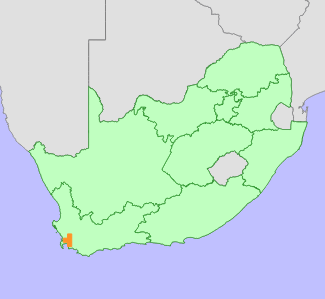|
Scientific Name | Lachenalia liliflora Jacq. |
Higher Classification | Monocotyledons |
Family | HYACINTHACEAE |
National Status |
Status and Criteria | Endangered B1ab(i,ii,iii,iv,v)+2ab(i,ii,iii,iv,v) |
Assessment Date | 2019/10/29 |
Assessor(s) | L. von Staden, G.D. Duncan, R. Koopman & D. Raimondo |
Justification | Lachenalia liliflora has a restricted distribution range, with an extent of occurrence (EOO) of 671 km², and an area of occupancy (AOO) of 28 km². Five small, severely fragmented subpopulations continue to decline due to ongoing habitat loss and competition from alien invasive plants. |
Distribution |
Endemism | South African endemic |
Provincial distribution | Western Cape |
Range | This species is endemic to a small area on the Western Cape's coastal lowlands between Tygerberg, Paarl and Gordon's Bay. |
Habitat and Ecology |
Major system | Terrestrial |
Major habitats | Swartland Shale Renosterveld, Swartland Granite Renosterveld, Boland Granite Fynbos |
Description | It occurs on seasonally moist, stony clay flats in renosterveld. |
Threats |
| At least 75% of this species' habitat is already irreversibly modified, predominantly due to habitat loss to urban expansion around Durbanville, Paarl, Stellenbosch and Somerset West. Loss to development continues. It has also lost habitat to agriculture in the Berg River Valley and on the Joostenberg Vlakte. All remaining subpopulations are in small remnants, where they are threatened by competition from alien invasive plants and inappropriate fire management - mainly fire exclusion. |
Population |
Field surveys of remaining lowland fragments around Tygerberg, Berg River Valley between Franschhoek and Paarl and Sir Lowry's Pass have recorded five remaining subpopulations. Plants were counted at four of these, indicating that the largest remaining subpopulation consists of about 200-350 plants. The fifth subpopulation was not counted, but it is assumed to be small, as it occurs on a small fragment of granite fynbos. The species is now locally extinct around Stellenbosch, Joostenberg, and Paarl, where it is known from historical records, but no intact habitat remains at any of the historical localities. The population is estimated to number between 370 and 720 plants, and is severely fragmented, as all individuals are in small, isolated subpopulations. It continues to decline due to ongoing habitat loss and degradation.
|
Population trend | Decreasing |
Assessment History |
Taxon assessed |
Status and Criteria |
Citation/Red List version | | Lachenalia liliflora Jacq. | EN B1ab(i,ii,iii,iv,v)+2ab(i,ii,iii,iv,v); C1 | Raimondo et al. (2009) | |
Bibliography |
Duncan, G. 2004. TSP collection sheet.
Duncan, G.D. 1988. Lachenalia handbook. Annals of Kirstenbosch Botanic Garden 17:1-71.
Goldblatt, P. and Manning, J.C. 2000. Cape Plants: A conspectus of the Cape Flora of South Africa. Strelitzia 9. National Botanical Institute, Cape Town.
Raimondo, D., von Staden, L., Foden, W., Victor, J.E., Helme, N.A., Turner, R.C., Kamundi, D.A. and Manyama, P.A. 2009. Red List of South African Plants. Strelitzia 25. South African National Biodiversity Institute, Pretoria.
|
Citation |
| von Staden, L., Duncan, G.D., Koopman, R. & Raimondo, D. 2019. Lachenalia liliflora Jacq. National Assessment: Red List of South African Plants version . Accessed on 2025/08/13 |
 Comment on this assessment
Comment on this assessment


